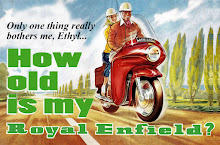 |
| Animation comparing an advertised VAX Interceptor "S" to Jeff's bike. |
"I'm sure that you know the story," the email began. But I didn't know the story and, as I read on, I could hardly believe it.
Jeff wrote from California to tell me about his Royal Enfield Interceptor, purchased as a project for Jeff and his 18-year-old son Mason to restore.
It is a 692cc Interceptor, built in 1960 as a scrambler, with a "VAX" engine number. Right there, Jeff wiped out what little I thought I knew about Royal Enfield's most powerful and perhaps most famous motorcycle, the Interceptor.
Royal Enfield Interceptors, I thought, were 736cc (nominally 750cc) machines, and they weren't introduced until 1962. And what did the "X" in VAX stand for?
Apparently, the "X," as usual in motor circles, stood for "something special." Jeff has a theory he shared recently with the
Interceptor Yahoo group.
"Cooper (the western importer for Royal Enfield) here in Los Angeles would have experienced a huge demand for scramblers in the late '50s, due to the widespread and growing popularity of scrambles races here in Southern California during that period. I believe that they correctly anticipated a growing market for scramblers and the need to compete aggressively with Triumph scrambler-type bikes imported into the U.S. via Johnson Motors in Los Angeles.
 |
| VAX Interceptor goes flying in 1960 Cycle magazine ad. |
"My guess is that Cooper convinced Enfield to produce a special batch of 700cc scramblers from Redditch, and that Enfield then created these scramblers at Cooper's suggestion, as an experiment to test the market, combining elements of the Constellation (engine, primary, gearbox, magneto, frame, seat, rear wheel), Fury (front end and front wheel) and Meteor (toolbox), stripping off any unnecessary bits, and calling them 'Interceptors.'
"The presumed intent was to blow the doors off of the competition by offering up the most powerful scrambler on the market. All of the engines destined for this Cooper-driven experiment were stamped X."
Jeff took the trouble to try to find out how many of these special machines were made, and got this response from the
Royal Enfield Owners Club (which holds the factory ledgers:
"A number of published articles have asserted incorrectly that Royal Enfield manufactured 211 VAX Interceptors. Careful analysis of the original Redditch factory dispatch ledgers by REOC Chairman Graham Scarth reveals that the actual quantity of 700cc Interceptors recorded is 158. These machines should all have engines with the VAX prefix. The engine prefix letters (Note: including that special letter "X") are not recorded in the Redditch ledgers, and there are 12 engines from the number sequence not accounted for in these books. As these engines could be either Constellation or Interceptor, the maximum possible quantity of VAX machines produced could be as high as 170."
 |
| Jeff's VAX Interceptor awakes from a long sleep. |
Jeff's motorcycle was purchased in Los Angeles at Cooper Motors, and has been stored in California since the mid-'60s. It has only 3,700 miles. It is in "unmolested" condition, he says, certainly unusual for a motorcycle that was intended for a rough life of racing. Here is a
gallery of pictures of Jeff's 1960 VAX Interceptor.
The 1959, '60 and '61 VAX Interceptors may be less well known today than other Interceptors, perhaps because at the time they apparently were strictly export machines for the U.S. market. Jeff has pulled together information including period advertisements touting the "700cc INTERCEPTOR — 52 HP SCRAMBLER — A super-potent competition model with a snarling acceleration and power."
Sounds terrific. So what happened then? More theories are out there:
1. The 692cc (nominally 700cc) motor was highly tuned and demanded more maintenance than the parent 692cc motor in the gentler Constellation. We all know what that leads to. (The new 736cc twin introduced on the 750 Interceptor in 1962 would be beefed up to handle its extra power.)
2. Even in lightened scrambler form, the 700cc Royal Enfield was too heavy to compete in the sand of Southern California.
3. Demand for big twin scramblers likely wasn't as strong as anticipated. Royal Enfield added an “S” (for “Sports”) trim kit. It was applied by the distributor in Los Angeles or by retailers, transforming the VAX scramblers into road bikes. Jeff believes that they were intent upon making the bikes more attractive to a broader audience in order to sell off remaining inventory and make way for impending sales of the 750.
He created the cool animation at the top of this page to show the amazing similarity between his his motorcycle and the advertised image of a 1960 VAX Interceptor "S".
 |
| It didn't take much to remove the headlight and go racing. |
"It is essentially a scrambler with road trim added," he said.
Rare, highly strung and maintenance intensive it may be: today these are all things that make the 700cc VAX Interceptor more interesting. Perhaps most importantly, it was the first Royal Enfield to wear the vaunted name of Interceptor.
 |
| Not much is missing from this mighty Interceptor. |

















































































